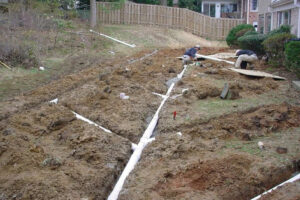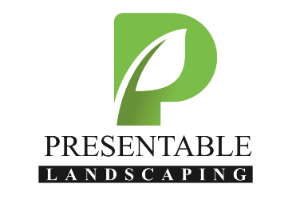
Understanding Landscape Drainage Systems
When it comes to landscape drainage, there are two primary types of systems: surface drainage and subsurface drainage. Surface drainage relies on gravity to direct water flow, while subsurface drainage operates below ground but functions similarly to surface drainage. These systems can be further enhanced with specialized drainage techniques and materials.
Surface Drainage Systems
Surface drainage systems are commonly used for irrigation or in areas with high rainfall. They work by utilizing gravity to direct water flow. There are two types of surface drainage systems: graded and bedded.
- Graded Surface Drainage Systems: This system involves creating a slope or grade in the landscape to facilitate water runoff. The slope allows water to flow away from the property and prevents pooling. Graded surface drainage systems are effective for managing excess water in flat or low-lying areas.
- Bedded Surface Drainage Systems: Bedded surface drainage systems utilize channels or beds to collect and redirect water. These systems are often used in conjunction with graded systems to ensure efficient water flow. Bedded systems are commonly employed in parking lots, athletic fields, and other large areas.
Subsurface Drainage Systems
Subsurface drainage systems also rely on gravity to manage water flow. These systems operate below ground but function similarly to surface drainage systems. Subsurface drainage can be implemented through various techniques and materials.
- French Drain Pipe Systems: French drains are popular subsurface drainage systems. They involve burying a perforated pipe surrounded by gravel. The gravel allows water to filter into the pipe, which directs it away from the landscape. French drains are particularly effective on sloping terrain.
- Filter Fabric or Multi-flow Drainage Systems: These systems utilize a series of stacked perforated pipes wrapped in a filter fabric. The fabric prevents the passage of soil particles while allowing water to flow. Filter fabric or multi-flow drainage systems strike a balance between soil filtration and water flow.
- Geotextile Fabric Systems: Geotextile fabric systems consist of a non-woven fabric with a high-density polyethylene core. This system allows for faster water flow, keeping water away from the landscape. Geotextile fabric systems are newer but proven to be highly effective.
Effective Landscape Drainage Techniques
Now that we have a basic understanding of landscape drainage systems, let’s explore some effective techniques to manage excess water on your property.
Rain Garden for Excess Water
A rain garden is a beautiful and practical solution for managing excess water. This self-sustaining system allows water to accumulate in a shallow depression, gradually filtering into the soil. Rain gardens are particularly effective in managing runoff from roofs, driveways, and other impervious surfaces.
To create a successful rain garden, choose a low-lying area where water naturally accumulates. The soil mix should be well-draining yet able to retain moisture during dry periods. Native plants are the best choice for a rain garden, as they are adapted to the local climate and thrive in wet conditions.
Water-Absorbing Plants
Integrating water-absorbing plants into your landscape can help manage excess water and prevent drainage problems. These plants thrive in wet conditions, preventing erosion and runoff. Native species are ideal, as they require less maintenance and are adapted to the local environment.
Consider incorporating water-absorbing plants such as dogwoods, willows, and red-twig throughout your landscape. These plants can be used in rain gardens or planted strategically to absorb excess water, promoting healthy drainage.
French Drain Systems
French drains are simple yet effective drainage solutions. They involve burying a perforated pipe surrounded by gravel. The gravel allows water to filter through and enter the pipe, redirecting it away from the landscape. French drains are particularly effective for managing excess water on sloping terrain.
Ensure the drain pipe’s size and capacity match the volume of water in your area. Proper placement is essential, as the drain pipe should be situated where water naturally accumulates.
Dry Well Systems
Dry wells act as underground storage systems, allowing excess water to slowly filter into the groundwater table. These systems involve directing downspouts or other drainage systems to a large underground well, where water can be stored and gradually absorbed into the soil.
Dry wells are a cost-effective and environmentally friendly alternative to French drains. They require less maintenance and are less likely to clog over time. However, they may not be as effective for managing larger volumes of water.
Corrugated Plastic Tubes
Corrugated plastic tubes are simple and effective drainage solutions. These perforated pipes, buried underground and connected to downspouts or other drainage systems, facilitate water flow. Surround the pipes with gravel to enhance drainage.
Corrugated plastic tubes are cost-effective and easy to install. They are particularly useful for diverting water from buildings and other structures.
Permeable Paving Materials
Permeable paving materials promote effective water management by allowing water to filter through into quick-draining gravel layers underground. These materials include concrete, asphalt, and plastic pavers with small gaps.
Ideal for driveways, walkways, and other outdoor surfaces, permeable paving materials prevent runoff and gradually seep water into the soil. They are available in various styles and colors, enhancing both functionality and aesthetics.
Grassy Swale
A grassy swale is a natural depression or ditch designed to channel excess water from one area to another. Lined with grass or vegetation, these swales absorb excess water and prevent erosion.
Grassy swales are effective for managing runoff from large areas, such as roofs, parking lots, or athletic fields. They can be combined with other drainage solutions, like French drains or dry wells, to create a comprehensive drainage system.
Additional Strategies for Effective Landscape Drainage
In addition to the techniques mentioned above, there are other strategies to manage excess water on your property:
- Creating Natural Barriers: Planting trees or shrubs around your property’s perimeter helps absorb excess water and prevent runoff.
- Installing Gutters and Downspouts: Properly installed gutters and downspouts direct water away from your home or other structures, preventing damage and erosion.
- Using Permeable Surfaces: Gravel, mulch, or crushed stone can absorb excess water and prevent runoff. These permeable surfaces are ideal for managing water flow.
Effective landscape drainage is crucial for maintaining a healthy and functional outdoor space. By implementing appropriate drainage systems and techniques, you can prevent water damage, soil erosion, and the breeding of disease-carrying insects. Whether you choose rain gardens, French drains, or permeable paving materials, it’s essential to consider your property’s specific needs. Consult with professionals to assess your drainage requirements and create a comprehensive landscape drainage plan. With the right approach, you can ensure proper water management and enjoy a beautiful, sustainable outdoor environment.
Contact us (859-640-0657) for a free consultation!
—
 About Presentable Landscaping
About Presentable Landscaping
Presentable Landscaping provides many landscaping services to our customers in Northern Kentucky and Greater Cincinnati.
- Clean ups
- Pruning / Trimming
- Paver Patios
- Mulching
- Retaining Walls
- Drainage
- Leaf Removal
- Gutter Cleaning

 About Presentable Landscaping
About Presentable Landscaping